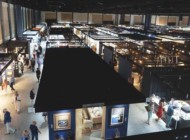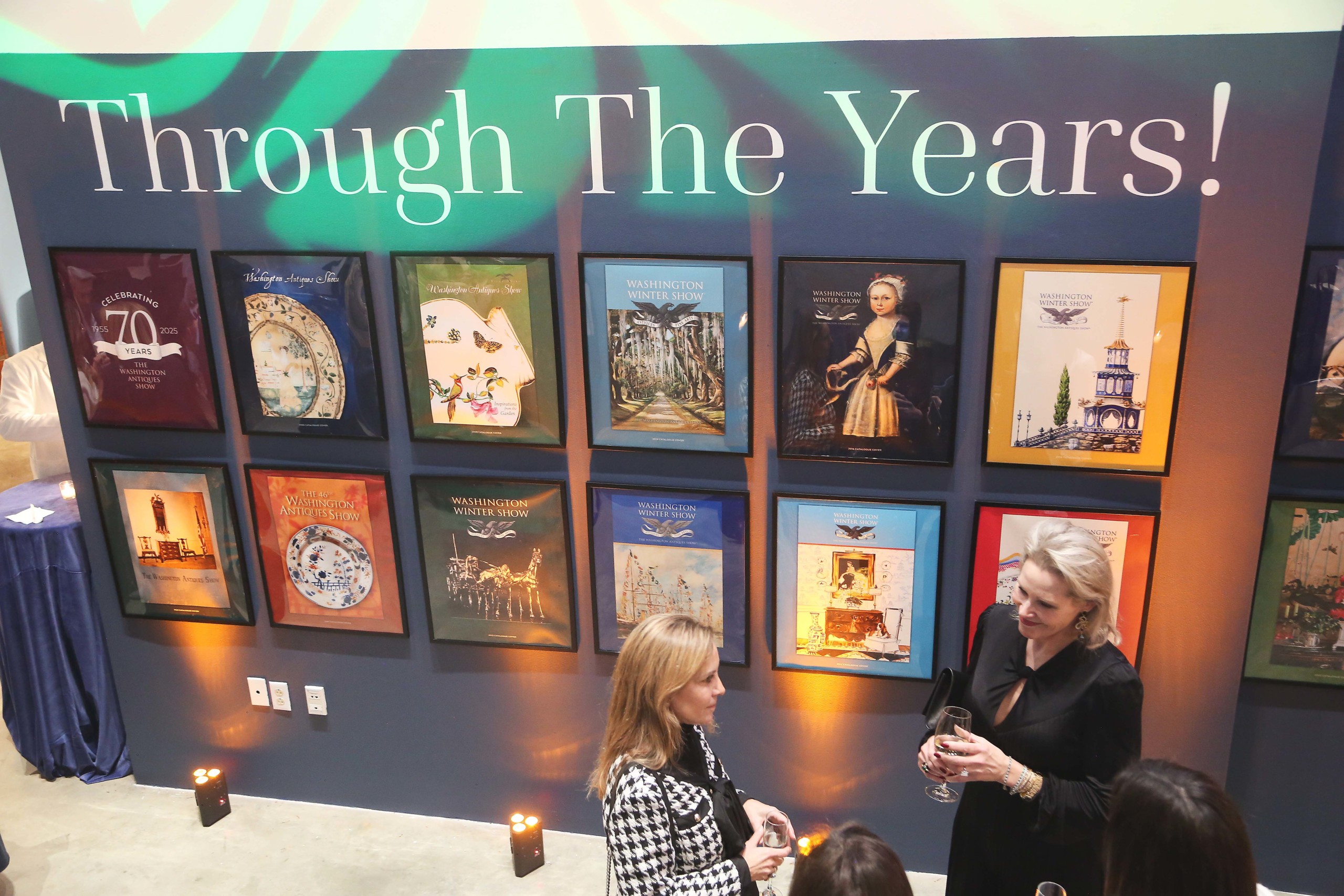
Just inside the show, copies of previous show catalogs were showcased to show off the event’s long history.
Review & Onsite Photos by Madelia Hickman Ring
WASHINGTON, DC — Many readers may not remember where they were 70 years ago today. The Washington Winter Show, however, was then just starting what would become a beloved event that still kicks off the New Year in the Capital. More than 40 dealers – including four making their inaugural debut – unpacked some of their best wares at the Katzen Art Center on the campus of American University. For three solid days, January 10-12, the multi-level show attracted hundreds of visitors, some who came to attend one or more of the many lectures or panel discussions.
Preview parties are usually glitzy social events and the one for this show — held this year on January 9 — usually ranks high on the list of comparable events at other shows. As it does every year, the DC society puts on its finest party clothes and braved sub-freezing temperatures to be rewarded with free-flowing drinks and food served up in a lively atmosphere.
The theme of this year’s show was “Preserving the Future of Our Past,” and the loan exhibition — titled “Preservation Pioneers: Lessons from Seven Historic Houses” — featured objects that helped tell the preservation stories of seven of the most illustrious mid-Atlantic-area historic properties: Stratford Hall (Stratford, Va.), Gunston Hall (Lorton, Va), Mount Vernon (Mount Vernon, Va.), Tudor Place (Washington, DC), Winterthur (Wilmington, Del.), Anderson House (Washington, DC) and Hillwood (Washington, DC).
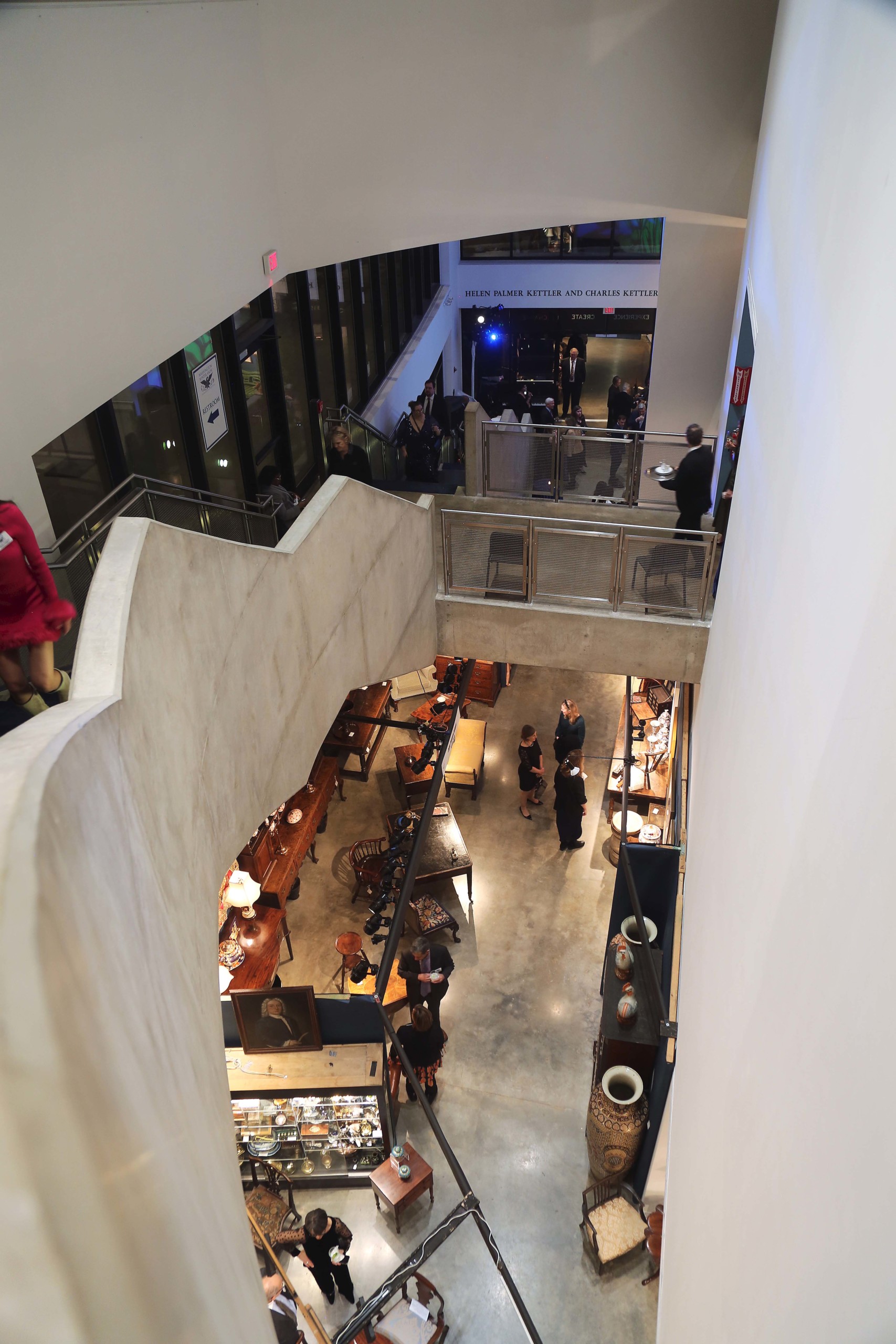
The three-story design and layout of the Katzen Arts Center meant there were antiques galore on every floor!
Mary Stuart “Puffin” Travers, the show’s director of development, noted the theme keys directly into its mission. “Looking at our communities — the charities it supports, our dealers, young collectors, patrons and benefactors — we’ve tried to come together and identify ways to celebrate our past while looking towards the show’s future. It sums up who we are as an organization, what we want to be and where we want to go. We find our attendees appreciate the story the objects tell and it’s truly important for us to honor that. The show generates tremendous energy among everyone involved and we had such a good time this year!”
The Decorative Arts Trust, a non-profit organization dedicated to promoting and fostering the appreciation of the decorative arts, included the show in its Washington, DC, study weekend on Friday, January 10, attending lectures by two emerging scholars, Tessa Payer, assistant curator of textiles and historic dress from Colonial Williamsburg and Dr Philippe Halbert, the Richard Kiipman associate curator of American decorative arts at the Wadsworth Atheneum Museum of Art. Additionally, the Trust toured the show with Josh Hildreth, Maria Crosby Pollard and the show’s manager, Karen DiSaia, and enjoyed a cocktail party and an hour of private shopping after the show closed.
“It was an amazing show,” enthused DiSaia when Antiques and The Arts Weekly reached her as she was driving home following the show. “It’s been building and building, and each year feels a little bit better to me. We had more people come and more people buy. The broad variety of things purchased was amazing to me; I don’t know anyone who didn’t do business during the show. Since it was the 70th year, people were really invested in making sure it went well.
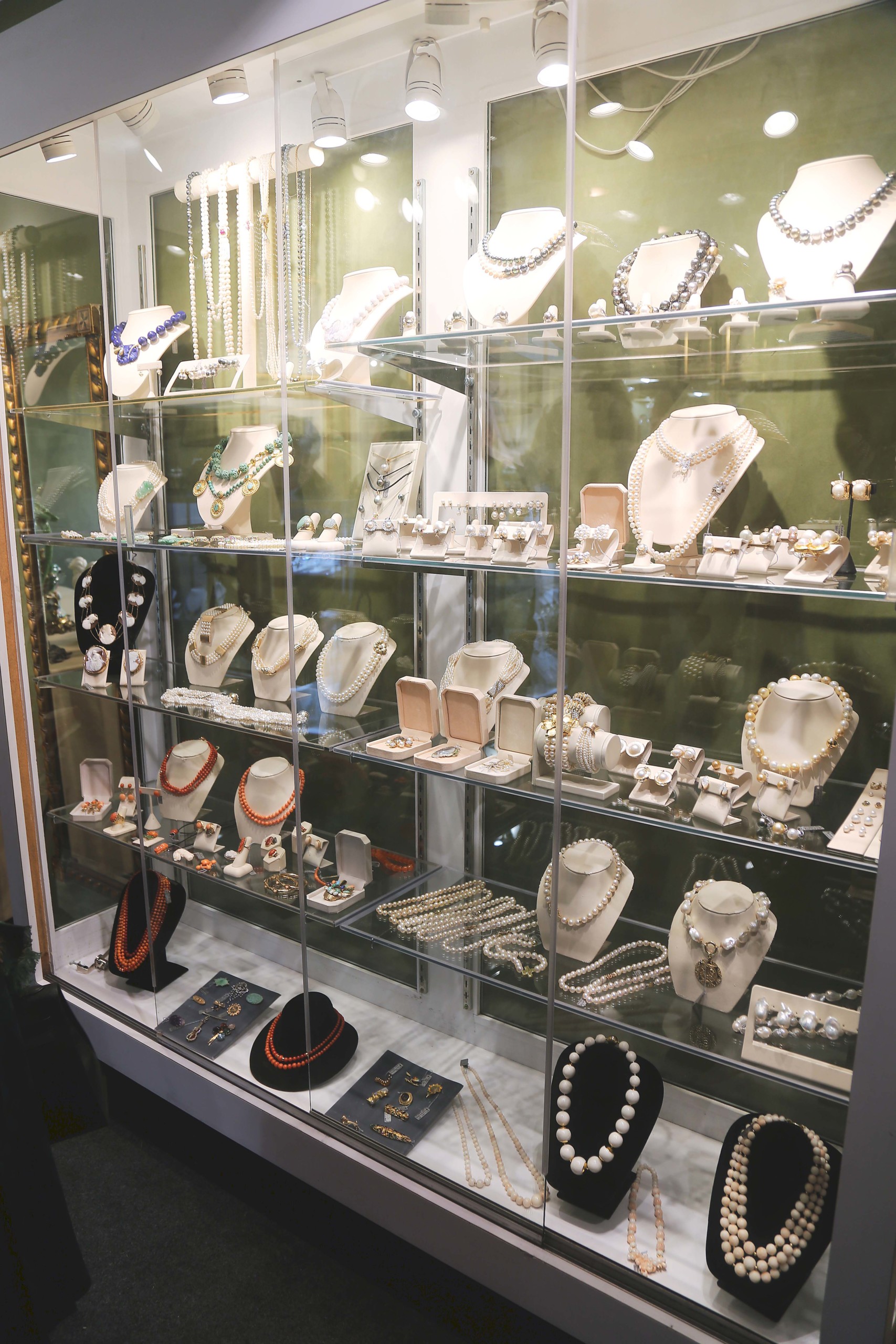
Pearl and coral estate jewelry were in plentiful supply with first-time exhibitors Alderman Ford, Columbia, S.C.
“We’ve been seeding this market for a long time and it’s paying off. Folks who used to come to Jazz Night on Saturdays now come on Opening Night because they want to be there before things sell. This year, we had so many people on Saturday night that it took us more than 30 minutes to clear the floor.”
She continued, “Elizabeth David, who as a child was one of our chairs when we started the Sundaes on Sunday program, is now graduating from college and she was at the show for Young Collector’s Night.”
The four new dealers to this year’s show were Alderman Ford Antiques (Columbia, S.C.), Arader Galleries (Philadelphia & New York City); Michael Paul Gunselman Antiques (Centreville, Del.) and The Parker Gallery (Hampshire, UK). Longtime silver dealer Thierry Doussiere was participating as Antique French Fine Arts alongside his wife, Jasmine, who is Silver Art by D&R (both are based in Baltimore and Marseille, France).
Lori Cohen of Arader Galleries occupied a substantial booth on the show’s second level and brought several works that would have interested local collectors. Foremost among these were two watercolor and gouache works by George Beck (1749-1812), who Cohen said was George Washington’s “favorite artist.” Considered to be among the earliest views of Georgetown and Washington, DC, “Georgetown and the City of Washington” and “A North View of the City of Washington,” both circa 1800, were hung on the gallery’s forward facing wall and were offered separately. Also of interest were a 1777 map of Maryland and Virginia after Joshua Fry and Peter Jefferson that was published by George Le Rouge and “The City of Washington” by Currier & Ives. For those looking for images of President Washington, Cohen had devoted one side wall to 10 images of the man, as well as one of his Mount Vernon estate.
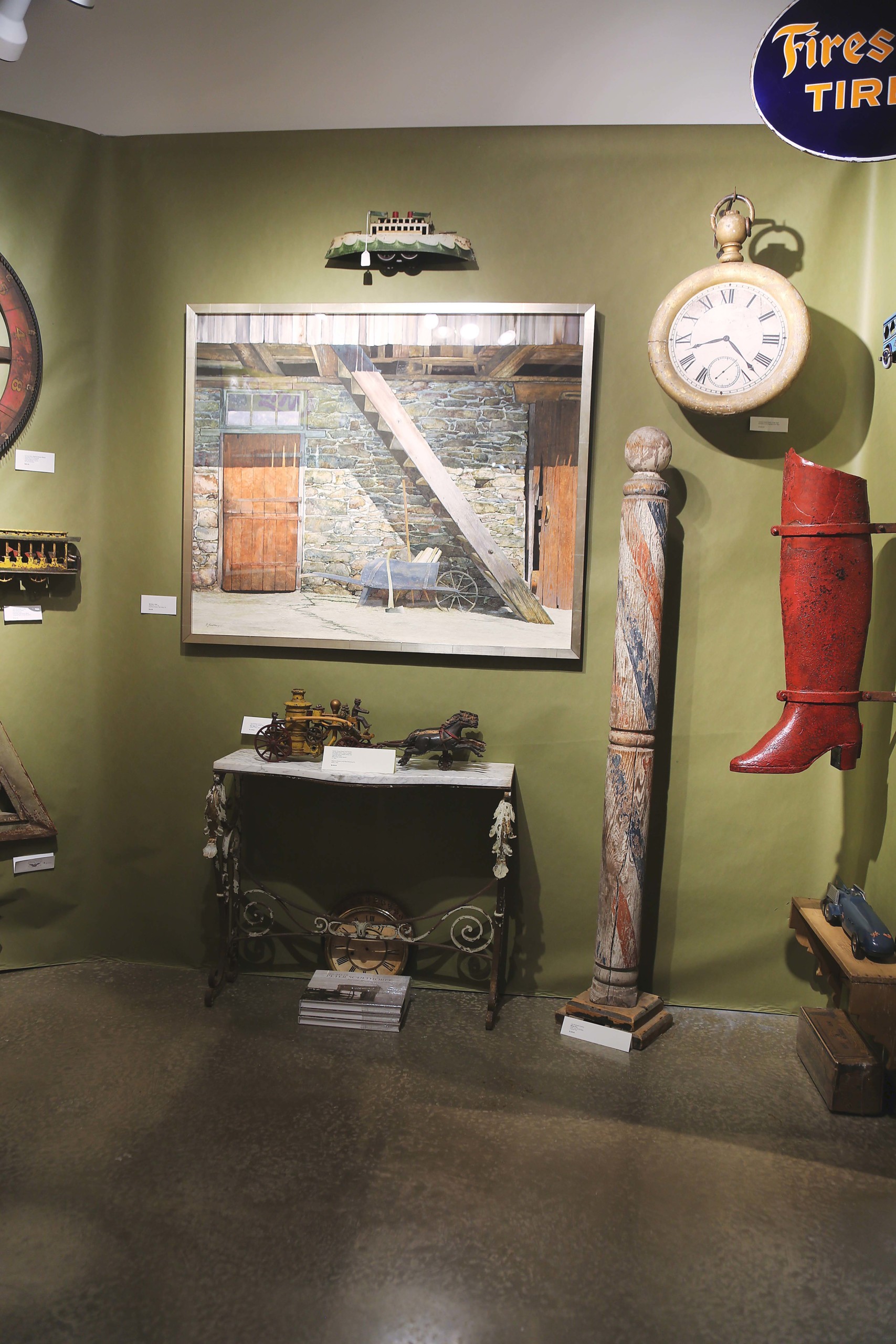
Michael Paul Gunselman, showing for the first time, is a friend of artist Peter Sculthorpe and offered to bring a few of his works to the show. “Summer’s Rest” is shown here among the cast and tin toys and painted objects the Rockland, Del., dealer specializes in.
Michael Paul Gunselman occupied a prime spot in the landing of the third floor. The antique toy dealer brought a good selection of tin vehicles, which are his specialty, but he also brought four works by Peter Sculthorpe, a contemporary Rockland, Del., artist whose work was influenced by Andrew Wyeth and who is a friend and neighbor of Gunselman. He sold a handful of items, including seven in the final hour of the show, though none of the Sculthorpe paintings sold; all but one of his sales were to new clients.
“At the end, it turned out to be better than what I expected. I had a flurry of sales right at the end: merry-go-rounds, Ferris wheels, roller coasters — all carnival-related — as well as two US Army planes and a US Army troop carrier and search light with the original box. I got a lot of compliments on my booth but what really stands out for me is I’ve never felt so welcomed at a show as the organizers made me feel. It was really wonderful from that standpoint,” he reported.
Archie Parker specializes in sporting art. The Hampshire, UK., dealer was in the US in early November, participating in the Delaware Antiques Show, which he’s done for a couple of years, but this was his first time doing the Washington show. If you like dogs and horses, his booth offered a good selection, as well as some marine paintings by Charles Martin Powell (British, 1775-1824).
Because platinum is the traditional gift for a 70th anniversary, we asked some of the jewelry dealers to show us some of the platinum jewelry they brought. Sandy Jacobs noted that platinum wasn’t really used until the early 1900s but she had a bar pin and brooch pendant that were both early Twentieth Century and stunning with platinum and diamonds. Glen LeRoux was wearing, on his sport coat lapel, a Cartier platinum and diamond brooch that dated to the 1950s or 1960s and was in the form of a constellation.
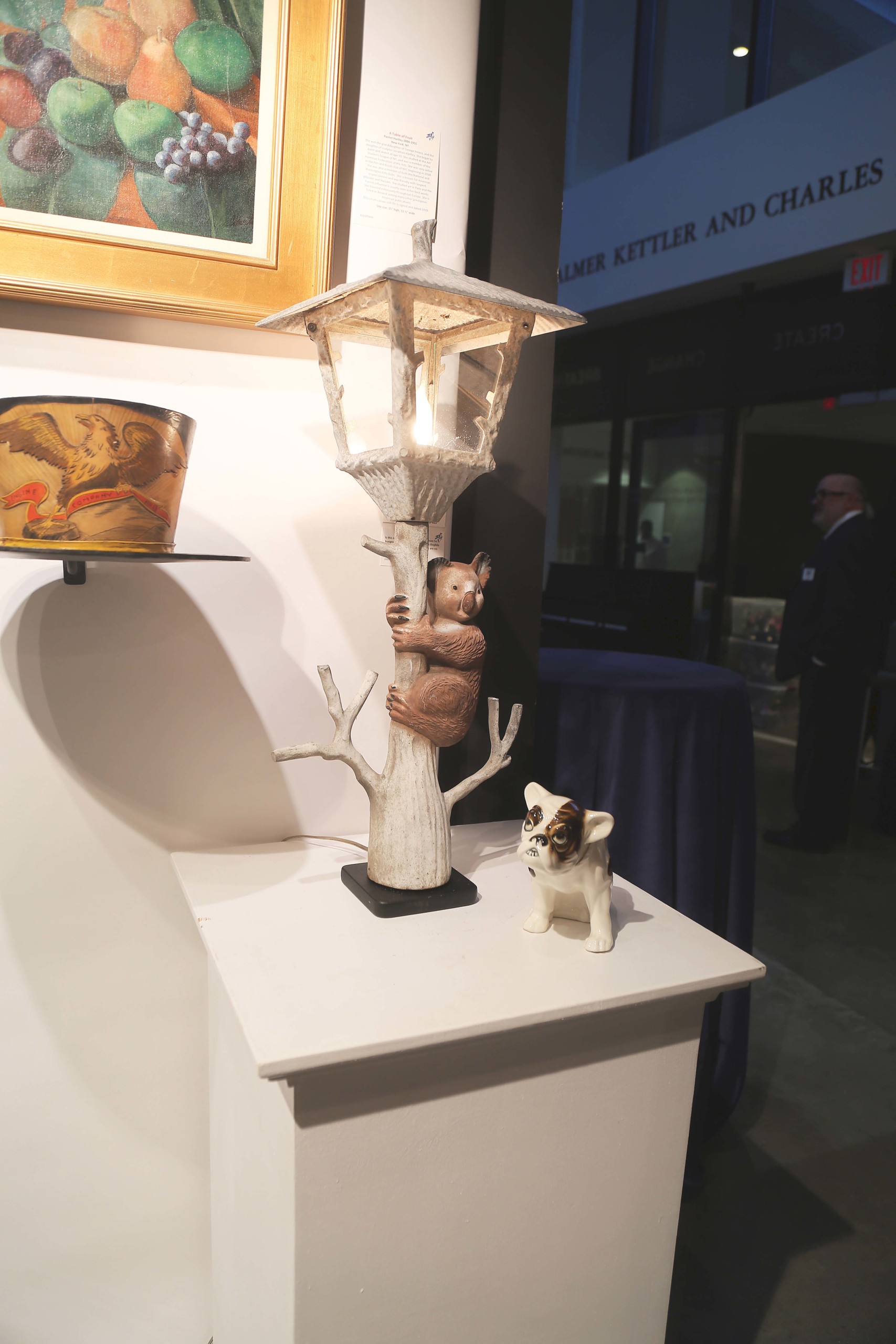
Most of the pieces Ron and Joyce Bassin sell come with a good story and this koala lamp was no exception. He said it had been a lamp post but their 7-year-old grandson Roman suggested they make it into a lamp, so they did. A Bird in Hand Antiques, Florham Park, N.J.
Joyce and Ron Bassin are A Bird in Hand Antiques and occupy a prime spot just inside the show’s entrance, on the first floor. Several pieces were pointed out as being both unusual and fresh to the market, including a bronze bison by Thomas François Cartier (French, 1879-1936) that dated to circa 1910; a pair of mid Nineteenth Century bronze partridges by Lambert Alexandre Leonard (French, 1821-1877) and a colorful bird tree with Carolina parakeets by Toledo, Ohio, artist Edwin Hurtti.
Taylor Thistlethwaite was opposite the Bassins and he enjoyed busy traffic through his booth on opening night. He reported having quite a few sales, to both new clients and old friends, with buying “all over the place.” Among the things he wrote receipts for were a big bust of George Washington, a painting and some prints, several “smalls,” a circa 1780 Maryland corner chair and a Brazilian Midcentury Modern coffee table.
Kevin Rita and Bill Wibel were steps away from both Thistlethwaite and the Bassins, and the Cape Cod dealers brought a small but choice selection of fine art, furniture, folk art and studio pottery. Flanking a display case with pottery, decoys and bronzes were a pair of painted chairs by Peter Hunt that Rita had acquired from a Falmouth, Mass., family this past summer. Behind the case were two striking landscapes: a Twentieth Century European school landscape titled “Distant Village,” and, by Patrick George (British, 1923-2016), “Oak Tree and View” from 1994. Rita noted that the latter had been in the collection of noted DC collector, Sally Pingaree; it found a new home during the show.
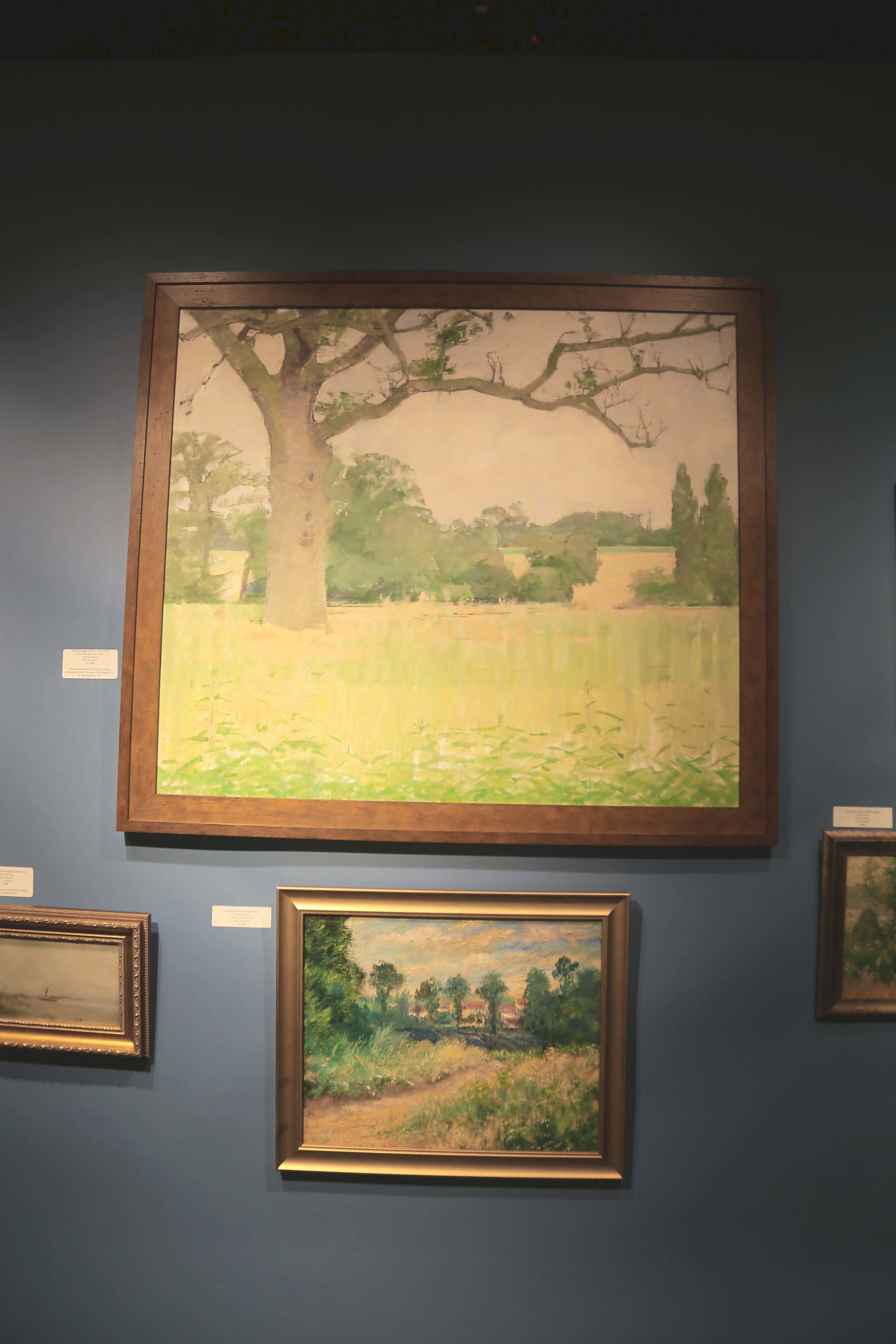
“Oak Tree and View” by Patrick George, 1994, oil on canvas, had provenance to a DC collection and found a new home during the show. Garvey Rita Art & Antiques, Orleans, Mass.
Francis J. Purcell trades in large and heavy things — notably garden statuary, mantels and architectural elements — and brought things that checked all those boxes to the show. Among wrought iron gates, painted mantels and mirrors was an impressive pair of white-painted cast iron urns, cast by the French foundry Val d’Osne, circa 1870, and mounted on plinths by J. L. Mott Ironworks of New York City.
French Accents Antiques was returning to the show for the second time and brought high-style European furniture, decorative arts and antiquities. The Baltimore, Md., dealer created several striking vignettes within their first-floor booth, one of which featured an Egyptian polychrome and giltwood mummy mask from the Ptolemaic to early Roman period (circa 332 BCE-641 CE). It was flanked by a pair of hand-painted Art Nouveau Doulton Lambeth pottery vases, decorated with fairies by Margaret Walker (circa 1891-1910) and situated underneath a French Art Nouveau giltwood mirror (circa 1890).
Collectors of traditional antiques would also find many things in the booth of Harrodsburg, Ky., dealer, Jayne Thompson. Several recently-acquired items were pointed out to us, including a four panel leather screen with a Chinoiserie scene of birds, butterflies and flowers within a dragon border; it was cataloged as either English or Dutch, circa 1800. Also identified were the leather upholstered sofa placed in front of the screen and a circa 1900 Uzbekistan Suzani silk embroidery that hung on the adjacent wall.
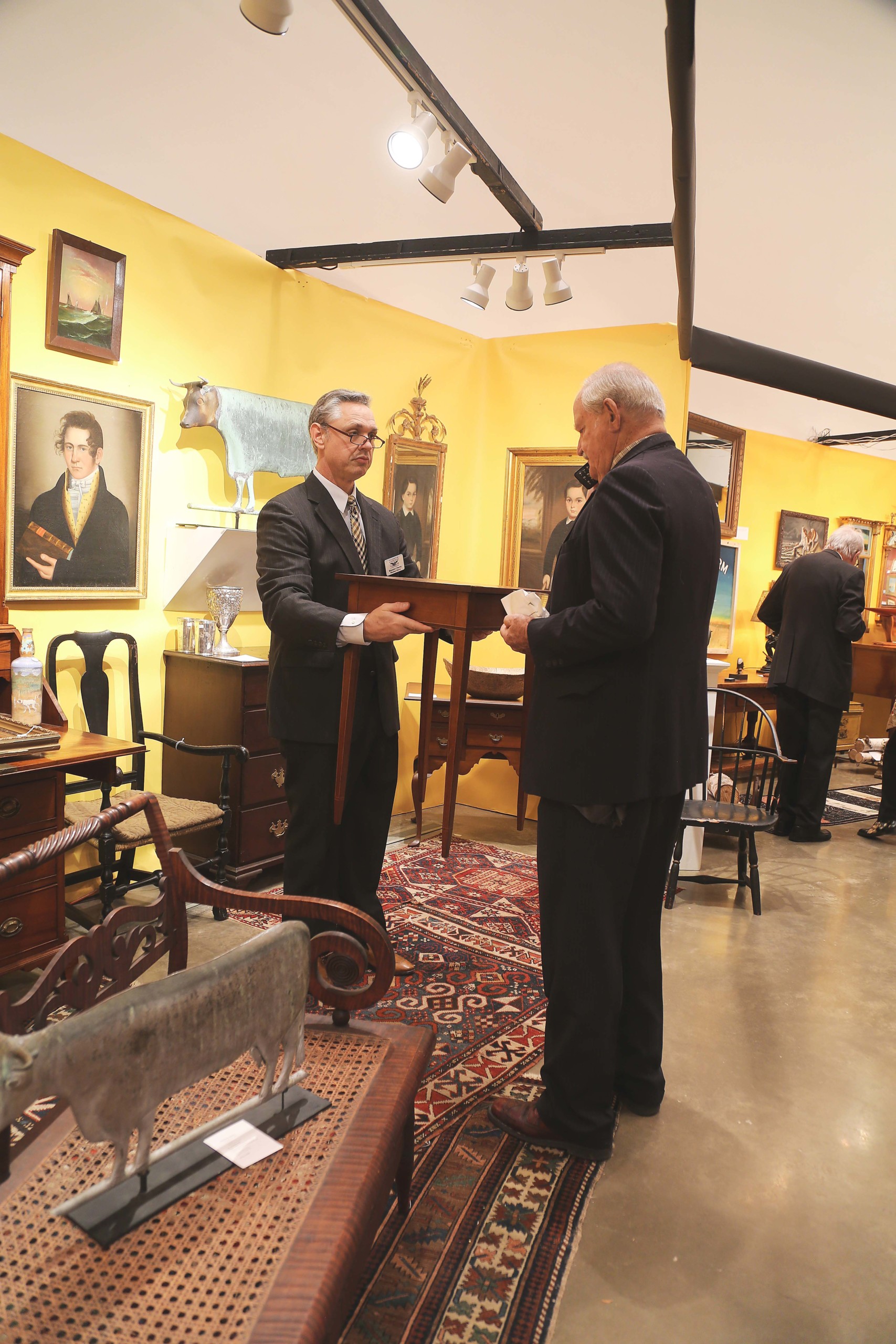
Blandon Cherry, left, holding up a Federal inlaid stand for a client to peruse. Blandon Cherry Antiques & Art, Paris, Ky.
Another dealer coming to Washington from Kentucky was Blandon Cherry, who was returning to the show following his 2024 debut. Some of his exceptional pieces included a wonderful crooked folk art cane; Peter Howell’s 1977 oil on canvas composition “Before the Race Starts”; a portrait of Silas Pickney Holbrook by Isaac Wetherbee that had provenance to Tom and Tess Schutte and Joan Brownstein; a Bucks County, Penn., desk and bookcase; a Berks County, Penn., clock; and a dressing table, attributed to either Eastern Connecticut or Rhode Island, which had also been in the Schutte collection and handled by Peter Eaton.
Returning for the second time as well was Christopher Evans, who had a small but well-positioned booth on the second floor. Anchoring the booth was a circa 1830 side chair from Philadelphia that was decorated with a painted eagle and flags. Not only had the chair been handled by folk art dealer David Schorsch but it was also illustrated in Debra Harding’s book, Stars and Stripes: Patriotic Motifs in American Folk Art (Rizzoli, 2002).
Evans’ neighbors were Tim Brennan and Dave Mouilleseaux, owners of Period to Mod Brennan & Mouilleseaux Antiques and Design. The Briarcliff Manor, N.Y., dealers have eclectic tastes, and their booth was a direct reflection of that. They like sets of things and offered a set of nine English scrapbook pages, a set of 12 circa 1930 French pochoirs (stencil-based prints) from Adrien Jacques Garcelon’s “Inspirations” and nine framed bird prints, among other things. On opening night, a pair of black-painted mirrors were tagged as sold, with other items following.
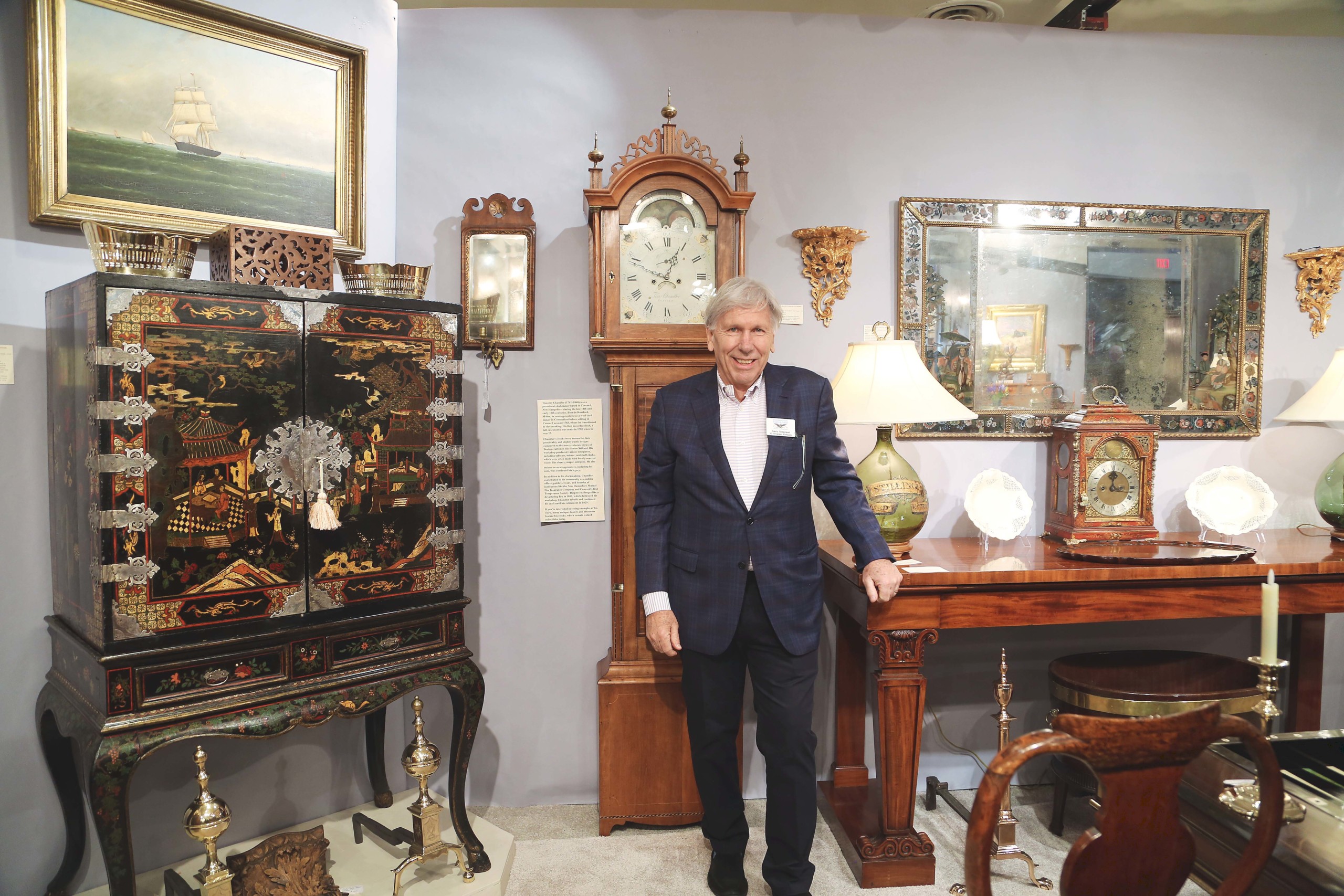
Gary Sergeant is shown here with two of the five pieces that attracted the most interest: a black lacquered chest on frame (left) and a reverse-painted mirror (center right) G. Sergeant Antiques, Woodbury, Conn.
Gary Sergent is known for handling superlative examples of American and English furniture, smalls and fine art, and his booth this year upheld his high standards. An important architect’s desk by Gillows, that was illustrated in Susan E. Stuart’s Gillows of Lancaster and London 1730-1840 (Antique Collectors Club, 2008) occupied pride of place in the center of the booth; according to its accompanying card, it was reported to be the most expensive piece ever manufactured by Gillows. His forward-facing wall hosted a Newport high chest, described as a “masterpiece” and referenced in a nearby copy of the American Furniture journal (Chipstone Foundation, 2004); it sold to a long-time collector from the Chevy Chase (Md.) area who had not purchased from him before.
When we spoke with Sergeant after the show, he said he had a good show. “What made it good was making things affordable. Once you get realistic about things, people are willing to come to the table and buy. When someone sees something that stimulates them, that’s 90 percent of the sale.” Five of the priciest things in his booth received the most interest — the Gillows architect’s desk, a black lacquered chest on frame, a reverse painted overmantel mirror, a pair of Gainsborough armchairs in a modern fabric and the Newport high chest. Alongside the high chest, he sold a ball and claw wingchair, “affordable smalls and some decorative things.”
Jasmine and Thierry Doussiere were next to Sergeant in a booth chock full of gleaming French silver and spectacular French paintings. “The Seine and the Cathedral in Rouen” by Robert Antoine Pinchon (1886-1943) hung over a stunning 212-piece Vermeil and silver flatware set made in Paris, circa 1880, by Henri Soufflot. On another wall, a circa 1880 four-part Surtout de table by Parisian silversmith Adolphe Boulenger provided a striking counterpart to Victor Charreton’s (1864-1936) serene composition, “The Abandoned Church in the Snow.”
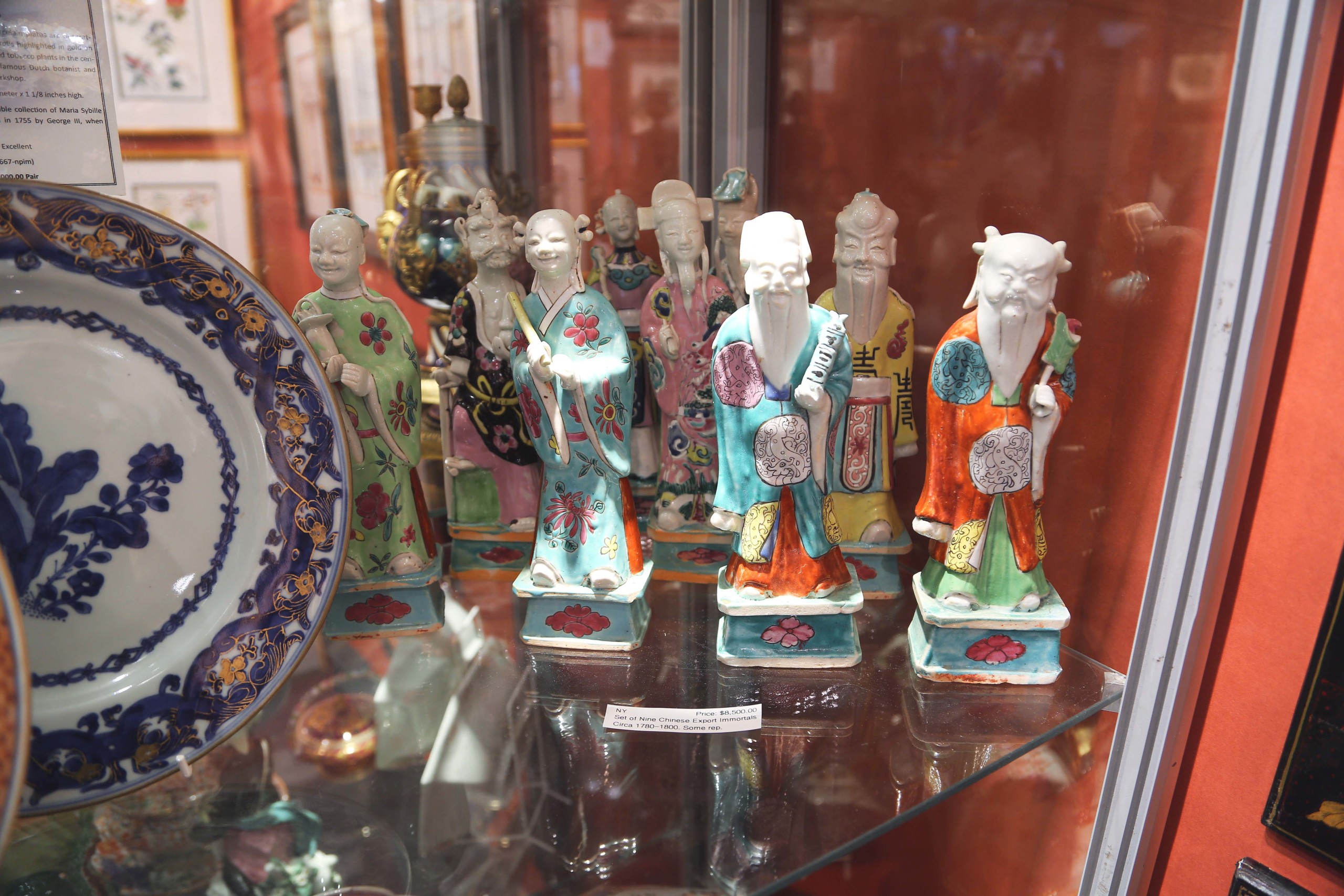
Earle D. Vandekar of Knightsbridge had recently acquired these nine Chinese export figures of immortals from a New Jersey collection. Downingtown, Penn.
RJ Ruble began doing the Washington Winter Show after the pandemic and says its one of his best shows. The Rochester, N.Y., dealer specializes in Japanese ceramics from the Seventeenth to the Nineteenth Centuries, which he thinks are “really underappreciated in today’s market” compared to comparable Chinese ceramics. Ruble pointed out two of his favorite pieces, both from the late Edo period and having strong decorative elements. The first was that of a sumo wrestler, the other depicted a carp.
On the second level, Paul Vandekar and Deirdre Healy were in fine form. Recent acquisitions on offer included a set of nine Chinese export figures of immortals that Vandekar said he got from a New Jersey collection; they also had a rare pair of English creamware tureens with covers and stands that dated to circa 1800.
Mason’s and English Ironstone porcelain and Japanese silk embroidery from the Meiji Period are Janice Paull’s bread and butter, available at every show the Delaware dealer participates in. Standing out was a selection of six woodblock cartoons made by Kobayashi Koyochika (1847-1915) between 1904 and 1905 as pro-Japanese propaganda during the Russo-Japanese War.
Paintings specialist David Brooker’s booth was divided by an aisle; one side featured contemporary art while the other side presented Nineteenth and Twentieth Century works. On the contemporary side, he had animal portraits by Jennifer Gennari, Charles Bertie Hall and Claude Stuart.
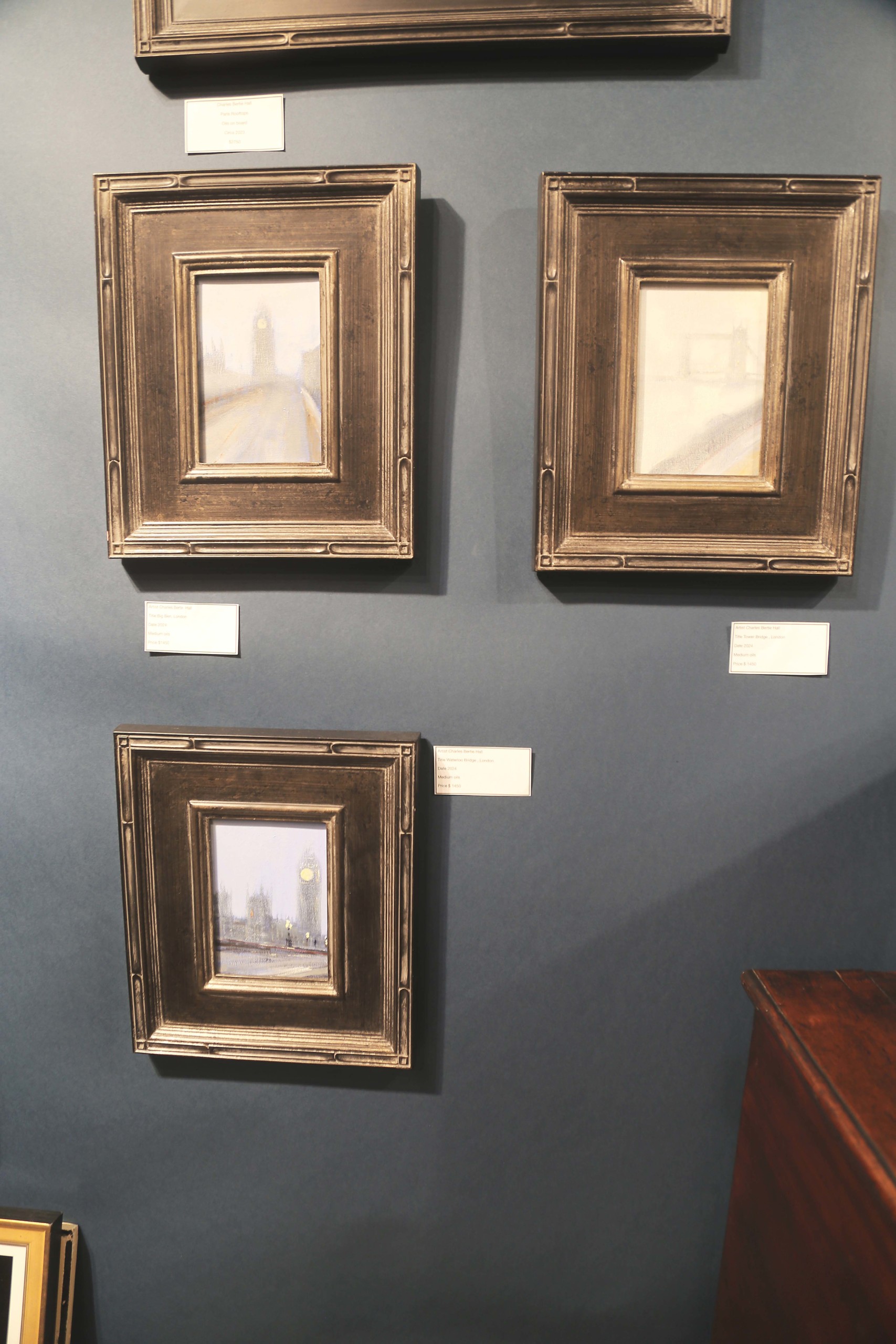
Each of these small oil landscapes of London were painted in 2024 by Charles Bertie Hall. David Brooker liked the foggy atmosphere each one evoked. David Brooker Fine Art, Woodbury, Conn.
Sheryl Dunleavy, principal of The Ann Parke Collection, was near the center of the third floor and offering a good assortment of fine art, furniture and smaller pieces. Anchoring her booth was a four-panel decoupage screen made in England, circa 1950, by Colefax and Fowler that she had found in an upstate New York apartment. The decorative motifs of the screen — described as an “ecosystem of botanicals and insects” — paired well with the animal and bird themes the Ann Parke Collection is known for.
Denise DeLaurentis was Dunleavy’s neighbor at the show, showing antique prints spanning every imaginable category, from maps and botanicals to bird prints, landscapes and historical scenes. She had closed the deal on two bird engravings when we came through: one of a flamingo (“Tab. XLVI”) and the other of the white heron (“Tab. IV”), both by Mark Catesby (English, 1692-1749).
Across from Dunleavy and DeLaurentis was Moylan/Smelkinson / The Spare Room. Specialists in Eighteenth and early Nineteenth Century English porcelain pottery, whimsical decorative objects and Georgian and Victorian jewelry, they were busy attending to Opening Night visitors. One of their standout pieces — which they used in their ad for the show’s catalog — was a circa 1880 Belle Époque ring studded with diamond-filled squares in a lattice pattern and centering a diamond, ruby and emerald. For porcelain, they proudly displayed a larger service of circa 1810 Mason’s Ironstone in a pattern they were calling “Blue Rose.”
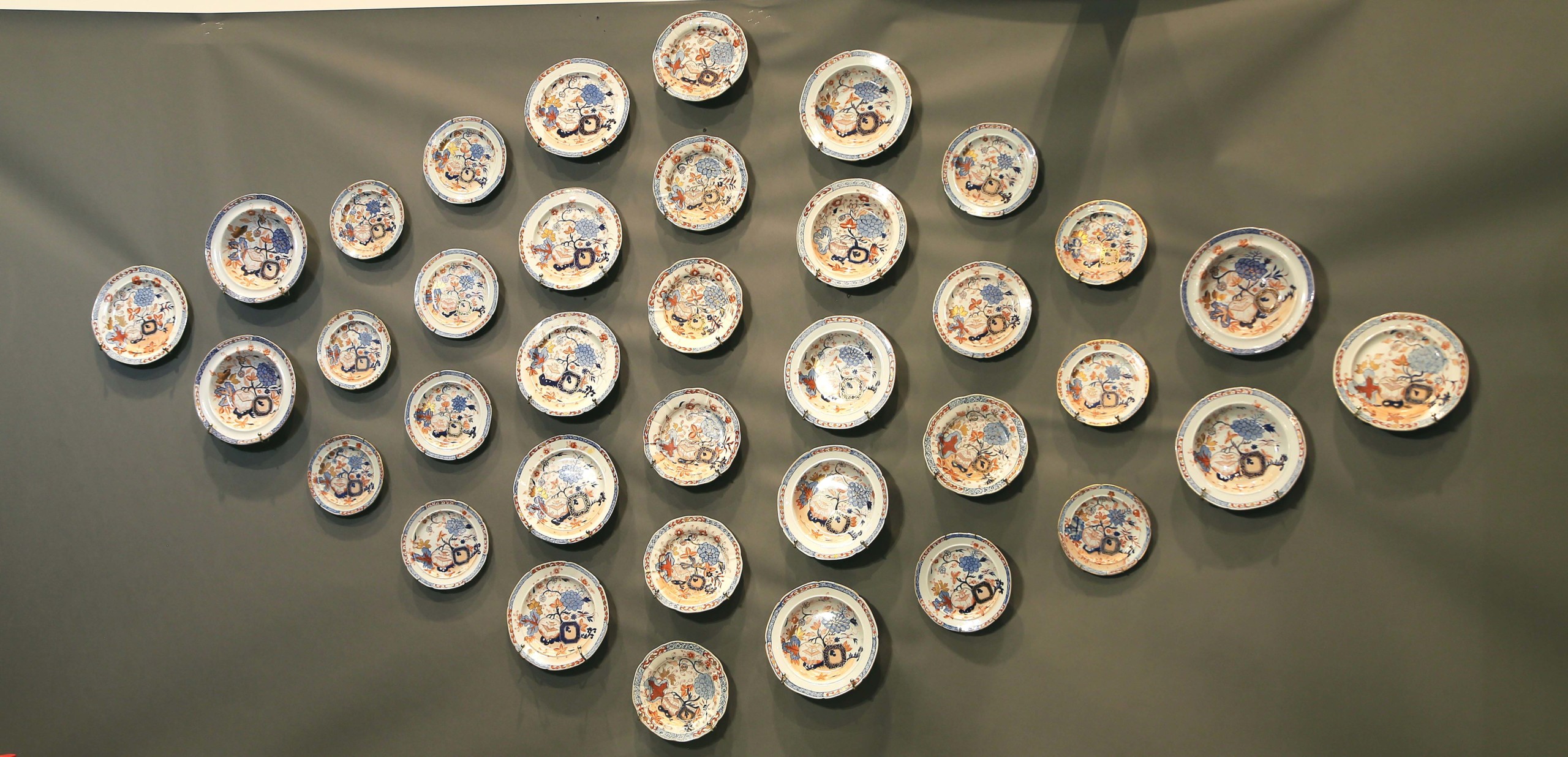
Though Mason’s Ironstone did not name their pattern, The Spare Room dubbed this the “Blue Rose” pattern; accompanying these plates were a set of seven graduated pitchers and five oval platters. Baltimore.
Both Roger Winter and John “Jay” Gates III and his wife, Susannah, brought enough furniture to fill most of the side section of the third floor. Case pieces, tables and seating furniture in both booths were augmented by paintings, porcelain and silver. Noteworthy in the booth of the former was a burled chest-on-chest, leather-topped library table, six-fold Chinoiserie screen and a Regency double-pedestal dining table.
The Gateses were busy discussing their inventory with numerous Opening Night attendees. After closing the deal on what Jay called “a really nice piece of Imari,” he pointed out several of their objects, notably a circa 1780 Scottish grandfather clock signed “J. Hall/Canongate,” the maker of which he said is still in business.
The 71st edition of the Washington Winter Show will return to American University and the Katzen Arts Center January 9-11, 2026. For information, www.washingtonwintershow.org.














































